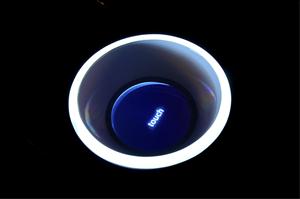2012/05/14
Dreams of a faucet. Design with the soul of water
Water is one of the basic necessities of life. We couldn’t survive a single day without it: it is part of us, our cities, our homes and our everyday life. We use it to drink, to wash, to freshen up, to have fun, and in all these activities we use articles to interact with this valuable resource.
Barcelona, February 2012. For the first time, Roca Barcelona Gallery brings to Barcelona Dreams of a faucet. Design with the soul of water, an exhibition on loan from the Empresa Nacional de Innovación (ENISA) of the Ministry of Industry, Energy and Tourism and the Círculo de Bellas Artes of Madrid. This exhibition explores the role of objects as intermediaries between us and water, and shows how design has become an indispensible tool for achieving a clear, human dialogue. Without this dialogue, we would be unable to use water, transport it or even protect ourselves from it.
The exhibition is curated by Héctor Serrano−a designer known for his reinterpretation of everyday articles that perfectly combine design and functionality− and Javier Esteban −co-creative and artistic director of Trizz and a collaborator in international projects with well-known brands such as Roca−. The event will be open to the public, free of charge, from 15 February to 13 May.
Dreams of a faucet. Design with the soul of water not only invites visitors to understand and contemplate the importance of water and how we relate to this natural resource, but also tackles necessary issues such as the shortage of water and the way in which designers solve problems as complex as drinkability and transportation, as well as water as part of the process involved in creating an object. The exhibition contains more than 40 items that describe our relationship with water from different vantage points.
Reinterpreting, Facilitating, Evolving
The display content is presented via the object that is most archetypal of our relationship with water –the tap– and is arranged in three sections: reinterpreting, facilitating and evolving. Each of these represents a unique vision of this relationship with water.
Reinterpreting reveals the creativity of the designers in resolving the relationship with water and presents a series of everyday objects that transform it. The section’s content is divided into three different installations: the Well and Town Square –where different projects can be discovered– and the Spring, which summons the visitor to look at water from a different viewpoint, admiring its beauty and appreciating its scarcity.
Some of the objects discovered by Reinterpreting are the W+W Roca, a design of Gabriele & Oscar Buratti and the Innovation Lab of Roca (2009) that combines the sink and WC in a single fixture that reuses sink water for flushing, thus reducing water usage and space; Table Tap, a table jug inspired by laboratory instruments, designed by Arnoust Visser for Droog (2008); and Ink Calendar, a calendar made from absorbent paper that colours the numbers day by day that was designed by Óscar Díaz (2007).
This area is also where we find Waterproof, a design from the curator Héctor Serrano for Metalarte (2003) consisting of a light fixture that turns on when it floats on water and in which the liquid is the ingredient needed for it to work. The device is a perfect example of the combination of innovative design, reinvention of everyday life and reinterpretation of our relationship with water.
Facilitating raises awareness of the problems inherent in access to desalinization, transportation or potabilization of water and displays objects designed and intended to mitigate these shortages. Taking on this problem is one of the primary goals of the We Are Water foundation, either through active collaboration in projects or through providing information on initiatives and solutions such as those shown in this section.
The articles in the section are a clear example of how design became a tool that provides simple solutions to complex problems in settings where infrastructures are lacking.
Lastly, Evolving sums up the history of Roca faucets as an archetype of the relationship with water. The pieces on exhibit illustrate the product’s history and the technology behind how it functions, as well as milestones in ecology and water conservation and progress in aesthetics.
Roca Barcelona Gallery
Roca Galleries are part of Roca's international strategy and a concept that expresses present-day realities and future challenges. Design, innovation, sustainability and well-being are Roca values expressed in the Galleries, which also convey the desire of the leading bathroom brand to maintain an ongoing dialogue with society and most particularly with professionals who share an interest and enthusiasm in shaping the future of bathroom spaces. The various Roca Galleries in London, Lisbon and Barcelona are a vehicle for expressing this desire, while providing a meeting place and area for open dialogue between interior decorators, designers and architects worldwide.
First opened in 2009, the Roca Barcelona Gallery is the result of a cooperative effort between the OAB architectural studio (Office of Architecture in Barcelona) directed by Borja, Lucía and Carlos Ferrater. The Roca Barcelona Gallery is a functional and flexible area where the Roca product showroom shares its space naturally with exhibitions, presentations, professional meetings and events of interest that further enrich the sociocultural offering of Barcelona.
Located on Carrer Joan Güell, the site is host to various exhibitions, debates, discussions and meetings on a variety of themes such as architecture, design, nature and sustainability. “Building Cities. The Best of European Architecture” (2010) “Aral. Lost Sea” (2010), “20 Designs: Dialogues Between Fashion and Literature” (2011) or “Oil Slick in the Gulf of Mexico” (2011-2012), are examples.
Key dates 2014-2015
- SEPT'14
- FEB'15
- MAR'15
- APR'15
- JUN'15
- SEPT'15
- OCT'15
Roca Madrid Gallery
October 2015








